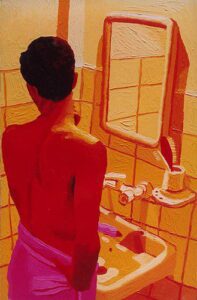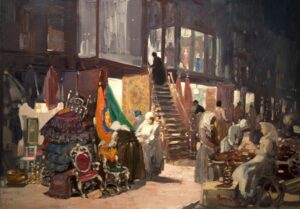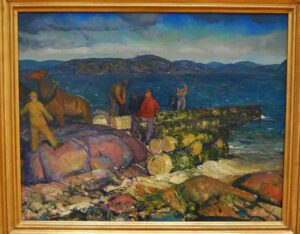The Ashcan School was a movement that turned the art world on its head, favoring gritty realism over the polished idealism of the time.
We’ll jump into how these rebellious artists captured the raw essence of early 20th-century urban life.
With their bold brushstrokes and unflinching eye, they brought the streets of New York to the canvas like never before.
Join us as we explore the legacy of the Ashcan School and its impact on American art history.
Origins Of The Ashcan School
The Ashcan School heralded a shift in American art at the turn of the 20th century that echoed the burgeoning realism in literature and theater.
At its core were a group of realist painters – including notable figures like Robert Henri, George Luks, William Glackens, and John Sloan – who were collectively dissatisfied with the prevailing aesthetic standards that favored the genteel and the pretty over the stark and the real.
It’s widely believed that the name “Ashcan” comes from a derisive reference to these artists’ willingness to depict the less glamorous aspects of city life – as though they were rummaging through trash for subject matter.
Our interest in this movement stems from its rawness and ability to capture life as it was lived by everyday people, like a candid snapshot frozen in oils or pastels.
In 1908, these artists solidified their vision in an exhibition at the Macbeth Galleries in New York City.
This showcase, often hailed as The Eight – after the number of artists involved – was groundbreaking not just for its content but also because it reveled in the grittier side of urban existence:
- Tenements and back alleys,
- Crowded street scenes,
- Laborers and entertainers.
Here’s the kicker: the Ashcan School wasn’t just about what was painted but how it was painted.
Their technique was often loose and vibrant, a stark contrast to the polished finish of academic painting of the era.
They worked quickly, capturing the dynamism and energy of the city, a trait that’s inherently cinematic in its approach.
For us in filmmaking, the Ashcan school artists are like the early documentarians, capturing unscripted moments full of life’s raw reality – a practice we resonate with deeply.
The Impetus For Change In Art
At the dawn of the 20th century, tension between traditional aesthetic values and the rapid modernization of society fueled artists’ desire for change.
The Ashcan School surfaced as an avant-garde force, pushing against the academic and romanticized sensibilities that dominated the mainstream art scene.
Urban growth and social reforms of the period inspired a shift in the art world – visionary artists felt compelled to record and reflect the times.
Industrialization had ushered in new challenges and experiences, and these realist painters believed art should evolve to be as dynamic as the new America.
Key Influencers And Events
Several prominent figures and events played critical roles in guiding the Ashcan School’s departure from established art traditions:
- Robert Henri – A pivotal mentor for the Ashcan collective, Henri advocated for portraying everyday life with honesty.
- The Armory Show in 1913 – This exhibition introduced American audiences to European avant-garde art, further shaking the foundations of conventional art in the U.S.
- Emerging forms of media – Early documentary films and photojournalism resonated with Ashcan artists’ aims to capture the unvarnished truth.
The Ashcan School mirrored the muckraking spirit in journalism, with its raw depictions serving as visual exposés of urban reality.
This approach was not just an artistic choice but also a form of social commentary, drawing attention to issues often swept under the rug.

Realism As Artistic Rebellion
Rebellion in art often manifests through radical techniques and subject matter, both staples of the Ashcan ethos.
The artists sought authenticity in their representations:
- Loose brushwork conveyed a sense of immediacy.
- Dark palettes and visible brush strokes evoked the gritty texture of city life.
Our passionate engagement with the Ashcan School reminds us that the canvas can be as powerful as the camera when it comes to capturing a society’s essence.
By portraying the stark and the beautiful, these artists ensured that future generations would have a window into the complexities of early 20th-century urban life.
Embracing The Gritty Realism
The Ashcan School artists were pioneers in portraying the raw, unvarnished reality of urban life.
They tackled subjects that mainstream art of the day considered too vulgar for fine art, including the daily lives of the working class and the bleak conditions they often faced.
This movement was not just about choosing unconventional subjects; it was about presenting them in a way that was honest and direct.
The artists utilized a palette that mirrored the murky atmosphere of the cities – the dark corners, the overcast skies, and the soot-covered buildings.
Among their oeuvre were scenes of:
- Crowded tenements,
- Smoky taverns,
- Lively street vendors.
The rawness was not merely in what they chose to depict but also in how they captured it.
Paintings like The Cliff Dwellers and McSorley’s Bar provide a window into the lively, albeit gritty, energy of early 20th-century American cityscapes.
It’s through works like these that we recognize the Ashcan School’s contribution to art history – a dedication to realism that spoke volumes about the socio-economic conditions of the time.
By refusing to gloss over the more sordid aspects of life, they brought a humanizing perspective to populations that were often ignored or hidden away.
Capturing The Raw Essence Of Urban Life
The Ashcan School was distinguished by its bold Try to capture the essence of city life.
As passionate observers, these artists immortalized the dynamic energy of the urban landscape with every brushstroke.
Their canvases are infused with the grit and rhythm of streets teeming with life.
Photography may freeze a moment in time, but the Ashcan painters were storytellers in oil, narrating the tale of the early American metropolis.
Reginald Marsh and John Sloan are two names often associated with this movement, painting the frenzied dance of humanity across their murky-hued compositions.
We recognize their works as visual time capsules:
- McSorley’s Bar by John Sloan – Why Not Use the L? by Reginald Marsh.
These pieces invite us into a world where the narrative is met with a rawness that is both unapologetic and starkly beautiful.
The Ashcan School artists harnessed their creative prowess to convey the hustle and bustle, exposing viewers to the heart of the city’s narrative.
Their art did not seek the refuge of romanticized cityscapes or gentrified veneers.
Instead, these pioneers delved into the chaos of immigrant neighborhoods, the poignant struggles of the working class, and the unrefined allure of street scenes.
Their brushstrokes defy silence, echoing the voices and stories that would otherwise go unheard.
The Influence Of The Ashcan School On American Art History
The Ashcan School’s legacy in American art is undeniable.
These artists set a new standard for truthfulness in artistic expression, inviting audiences to confront the realities of city life rather than retreat into idyllic landscapes or idealized subjects.
Their work paved the way for future movements to explore themes of social realism and urban experience with a similarly candid approach.
Their emphasis on the everyday brought about crucial conversations About class, social justice, and the urban experience.
The bold choice to depict the gritty sides of American life challenged the status quo and redefined what could be considered worthy of artistic merit.
This represented a seismic shift in the narrative of American art history, one that would resonate throughout the 20th century and beyond.
Prominent figures like George Bellows and John Sloan inspired generations of artists to embrace the full spectrum of human experience in their work.
They provided new lenses through which to view the lives of ordinary Americans, broadening the narrative scope and diversity of characters within the American artistic canon.
- Key contributions included: – Transcending the exclusive focus on European traditions and aesthetics – Elevating urban and working-class subjects to the realm of fine art – Influencing later social realist artists during the Great Depression.
Works such as Bellows’ Stag at Sharkey’s and Sloan’s McSorley’s Bar not only captured the vibrancy and vigor of the cities they portrayed but also invited reflection on social contrasts and human resilience in the face of urban challenges.
These paintings remain among the most studied and celebrated pieces of the Ashcan School, demonstrating their lasting impact on the trajectory of American art.
What Is Ashcan School In Art – Wrap Up
The Ashcan School left an indelible mark on American art, challenging perceptions and embracing the rawness of urban life.
Through their bold brushstrokes and somber colors, these artists brought the everyday struggles and vibrant energy of the city to the forefront of the public’s consciousness.
Their works not only reflect a pivotal moment in art history but also continue to resonate with audiences today, reminding us of the power of realism and the importance of representing all facets of human experience.

We’ve seen how their legacy paved the way for future art movements and how their dedication to depicting truth has broadened the horizons of what art can convey.
The Ashcan School’s influence remains a testament to the enduring spirit of innovation and the relentless pursuit of authenticity in art.
Frequently Asked Questions
What Is The Ashcan School?
The Ashcan School was an artistic movement that arose in the early 20th century, focused on realistically depicting the gritty urban life of American cities through dark palettes and unidealized subjects.
Who Were The Artists Associated With The Ashcan School?
Key artists of the Ashcan School include George Bellows, John Sloan, and others who shared the goal of representing everyday life and the stories of common people in their art.
What Subjects Did Ashcan School Artists Depict?
Ashcan School artists portrayed the often-overlooked aspects of city life, such as crowded tenements, smoky bars, street vendors, immigrant neighborhoods, and the daily lives of the working class.

Why Was The Ashcan School Important In Art History?
The Ashcan School was crucial in art history for pushing the boundaries of suitable artistic subjects by choosing realist and sometimes harsh urban scenes, thereby influencing future movements towards social realism.
Did The Ashcan School Artists Only Use Oil Paintings?
While oil paintings were prevalent among Ashcan School artists, they also utilized other mediums, but their main aim was to capture the essence and vigor of city life, regardless of the medium.
What Is The Legacy Of The Ashcan School In Modern Art?
The legacy of the Ashcan School in modern art includes an expanded narrative scope in artwork, embracing a broader spectrum of human experience and paving the way for subsequent artists to explore social and urban themes.
Who Are Some Celebrated Ashcan School Artists And Their Works?
George Bellows and John Sloan are celebrated Ashcan artists; notable works include Bellows’ boxing scenes and Sloan’s depictions of New York City life, which continue to be studied and admired today.


